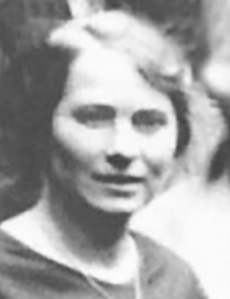
Back سابينا شبيلرين Arabic سابينا سبييلراين ARZ سابینا اسپیلرین AZB Сабина Шпилрайн Bulgarian Sabina Spielrein Catalan Sabina Spielrein Czech Sabina Spielrein German Σαμπίνα Σπιλρέιν Greek Sabina Spielrein Esperanto Sabina Spielrein Spanish
Sabina Spielrein | |
|---|---|
 | |
| Born | Sheyve (Elisheva) Naftulovna Spielrein 7 November 1885 OS |
| Died | 11 August 1942 (aged 56) |
| Nationality | Russian |
| Alma mater | University of Zurich (M.D., 1911) |
| Known for | death instinct child psychotherapy psycholinguistics |
| Spouse |
Pavel Nahumovich Sheftel
(m. 1912; died 1936) |
| Scientific career | |
| Fields | Psychotherapy Psychoanalysis |
| Institutions | Rousseau Institute |
| Doctoral advisor | Eugen Bleuler Carl Jung |
| Notable students | Alexander Luria Lev Vygotsky |
| Part of a series of articles on |
| Psychoanalysis |
|---|
 |
Sabina Nikolayevna Spielrein[1] (Russian: Сабина Николаевна Шпильрейн, IPA: [sɐˈbʲinə nʲɪkɐˈlajɪvnə ʂpʲɪlʲˈrɛjn]; 7 November 25 October 1885 OS – 11 August 1942) was a Russian physician and one of the first female psychoanalysts. She was in succession the patient, then student, then colleague of Carl Gustav Jung, with whom she had an intimate relationship during 1908–1910, as is documented in their correspondence from the time and her diaries.[2][3][4] She also met, corresponded, and had a collegial relationship with Sigmund Freud. She worked with and psychoanalysed Swiss developmental psychologist Jean Piaget.[5] She worked as a psychiatrist, psychoanalyst, teacher and paediatrician in Switzerland and Russia.[6] In a thirty-year professional career, she published over 35 papers in three languages (German, French and Russian), covering psychoanalysis, developmental psychology, psycholinguistics and educational psychology.[7][8] Among her works in the field of psychoanalysis is the essay titled "Destruction as the Cause of Coming Into Being", written in German in 1912.[9][10]
Spielrein was a pioneer of psychoanalysis and one of the first to introduce the concept of the death instinct. She was one of the first psychoanalysts to conduct a case study on schizophrenia and have a dissertation appear in a psychoanalytic journal.[11] Spielrein is increasingly recognized as an important and innovative thinker who was marginalized in history because of her unusual eclecticism, refusal to join factions, feminist approach to psychology, and her murder in the Holocaust.[7][12]
- ^ Also transliterated Shpilrein, Shpilrain, or Shpilreyn.
- ^ Carotenuto, Aldo, ed. (1982). A Secret Symmetry: Sabina Spielrein between Jung and Freud. New York, NY: Random House.
- ^ Carotenuto, Aldo, ed. (1986). Tagebuch einer hemlichen Symmetrie: Sabina Spielrein zwischen Jung und Freud. Freiburg: Kore.
- ^ Lance S. Owens, Jung in Love: The Mysterium in Liber Novus (Gnosis Archive Books, 2015), 27-35. ISBN 978-0692578278 (Online edition available.)
- ^ Schepeler, E. M. (1993). "Jean Piaget's experiences on the couch: Some clues to a mystery". International Journal of Psycho-Analysis. 74 (2): 255–273. PMID 8491531.
- ^ Etkind, Alexander (1997). Eros of the Impossible: The History of Psychoanalysis in Russia. Boulder, CO: Westview Press. p. 172.
- ^ a b Launer, John (2014). Sex Versus Survival. The Life and Ideas of Sabina Spielrein. London: Bloomsbury Publishing. ISBN 978-0-715-64741-7.
- ^ Richebächer, Sabine (2005). Eine fast grausame Liebe zur Wissenschaft. Munich: BTB.
- ^ Spielrein, S. (1912). "Die Destruktion als Ursache des Werdens". Jahrbuch für Psychoanalytische und Psychopathologische Forschungen. 4: 464–503.
- ^ Spielrein, S. (1994). "Destruction as the Cause of Coming into Being". Journal of Analytical Psychology. 39 (2): 155–86. doi:10.1111/j.1465-5922.1994.00155.x.
- ^ "Sabina Spielrein".
- ^ Covington, C.; Wharton, B., eds. (2003). Sabina Spielrein: Forgotten Pioneer of Psychoanalysis. Hove: Brunner-Routledge.
© MMXXIII Rich X Search. We shall prevail. All rights reserved. Rich X Search